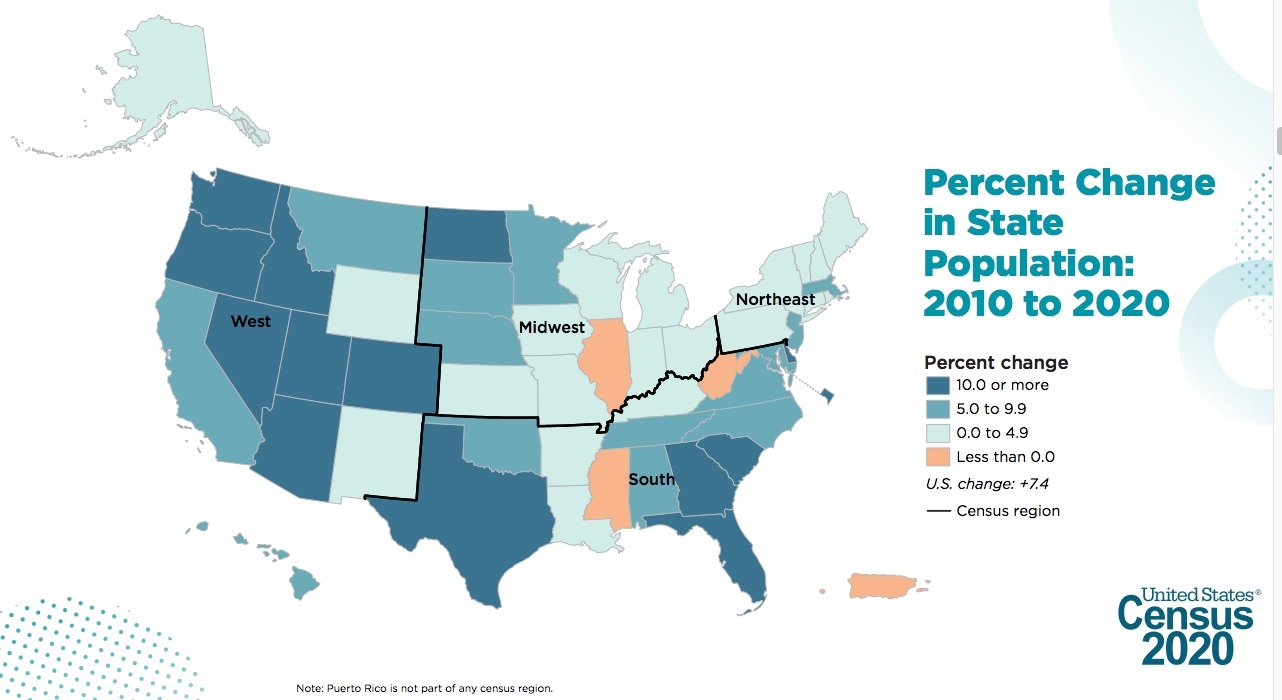
Cumberland County added more than 15,000 residents between 2010 and 2020 (a 5 percent increase) and, with 334,728 people, remains North Carolina’s fifth most populous county.
The latest population numbers, released Thursday by the Census Bureau, show that Harnett County added nearly 19,000 people over the past decade. The 16.5 percent increase made it the 11th-fastest growing county in the state. With 133,568 residents, Harnett is now the 25th most populous county.
Meanwhile, two counties in the Fayetteville area saw significant population losses. Robeson County lost 17,638 residents, a 13 percent decrease and the most overall in the state. Bladen County lost 5,584 residents, a nearly 16 percent drop.
North Carolina’s overall population grew from 9,535,483 to 10,439,483 over the decade, an increase of 903,905 or 9.5 percent. The growth makes it one of six states that will gain a U.S. House seat.
The latest numbers also show that Wake is now the state’s most populous county. The home of the state capital, Raleigh, Wake has grown by 228,417 in the past 10 years to 1,129,410, eclipsing Mecklenburg’s 1,115,482.
Wake’s neighbor, Johnston, was the fastest growing county in the state, Wake was fourth (25 percent) and Durham was 5th (21 percent). That means the Research Triangle added nearly 350,000 residents since 2010, the last census. Over that same period, 51 North Carolina counties lost population and 49 grew.
Although Wake is now on top, the top the five largest counties in 2020 were also the five largest in 2010: Wake, 1,129,410; Mecklenburg, 1,115,482; Guilford, 541,299; Forsyth, 382,590; and Cumberland, 334,728.
Wake (25 percent), Mecklenburg (21 percent) and Guilford (11 percent) grew faster than the state (9.5 percent) over the decade while Forsyth (9 percent) and Cumberland (5 percent) grew more slowly.
Tyrrell County remains the least populous county in North Carolina and five smallest counties are the same as in 2010: Tyrrell, 3,245; Hyde, 4,589; Graham, 8,030; Jones, 9,172; and Camden, 10,355.
After a decade of population estimates suggesting that Brunswick was the fastest-growing county, Johnston took a slight edge in the end. The five fastest-growing counties in North Carolina from 2010-2020 were: Johnston, 27.9 percent; Brunswick, 27.2 percent; Cabarrus, 26.8 percent; Wake, 25.4 percent; Durham, 21.4 percent.
The counties with the largest numeric declines were: Robeson, -17,638; Duplin, -9,790; Edgecombe, -7,652; Columbus, -7,475; and Halifax, -6,069
The counties with the largest percentage losses were: Tyrrell, -26.4 percent; Hyde, -21.0 percent; Northampton, -20.9 percent; Anson, -18.2 percent; and Washington, -16.8 percent.
The expanded data released Thursday showed an increase in the population of U.S. metro areas, an increasingly diverse nation and, for the first time in the nation’s history, a decline in the white population.
“These changes reveal that the US population is much more multiracial, and more racially and ethnically diverse, than what we measured in the past,” said Nicholas Jones, the director of race, ethnicity, research and outreach for the Census Bureau's Population Division.
The population of the nation’s metro areas grew by 9 percent from 2010 to 2020, resulting in 86 percent of the population living in U.S. metro areas in 2020, compared to 85 percent in 2010.
At 57.8 percent, the non-Hispanic white population remains the largest race or ethnic group, but the percentage declined by 8.6 percent since 2020, making it the lowest share on record.
“Many counties within metro areas saw growth, especially those in the south and west. However, as we’ve been seeing in our annual population estimates, our nation is growing slower than it used to,” said Marc Perry, a senior demographer at the Census Bureau. “This decline is evident at the local level where around 52 percent of the counties in the United States saw their 2020 Census populations decrease from their 2010 Census populations.”
County and metro area highlights
The largest county in the United States in 2020 remains Los Angeles County with over 10 million people.
The largest city (incorporated place) in the United States in 2020 remains New York with 8.8 million people.
312 of the 384 U.S. metro areas gained population between 2010 and 2020.
The fastest-growing U.S. metro area between the 2010 Census and 2020 Census was The Villages, FL, which grew 39 percent from about 93,000 people to about 130,000 people.
A total of 72 U.S. metro areas lost population from the 2010 Census to the 2020 Census. The U.S. metro areas with the largest percentage declines were Pine Bluff, Arkansas and Danville, Illinois, at -12.5 percent and -9.1 percent, respectively.
Fayetteville area
Cumberland County
2010: 319,431
2020: 334,728
Change: +15,297
Rate: +5 percent
Harnett County
2010: 114,678
2020: 133,568
Change: +18,890
Rate: 16.5 percent
Robeson County
2010: 134,168
2020: 116,530
Change: -17,638
Rate: -13 percent
Moore County
2010: 88,247
2020: 99,727
Change: +11,480
Rate: 13 percent
Hoke County
2010: 46,952
2020: 52,082
Change: +5,130
Rate: 11 percent
Bladen County
2010: 35190
2020: 29,606
Change: -5.584
Rate: -16 percent

The Advanced Contractors Academy, a free six-week program, is designed for established contractors ready to pursue larger-scale public contracts with agencies such as Fayetteville State University (FSU), Cumberland County and Cape Fear Valley Health.

Hungry Snacks Vending LLC is owned and operated by Kelton Battle, a young entrepreneur born and raised in Fayetteville. With 140 vending machines across the state, Battle is excited to continue expanding his business and to eventually manufacture and

A total of 84 interns participated in this year’s My Future So Bright program. At the graduation ceremony held on Aug. 1, each student was able to receive their graduation certificates from Mid-Carolina Regional Council Executive Director Saman